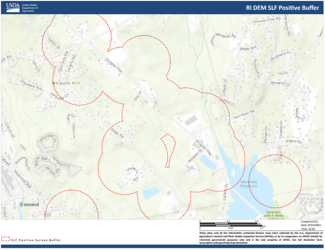DEM Announces It Will Treat Targeted Sections of Lincoln that have Spotted Lanternfly Infestations with Insecticide
Published on Wednesday, November 02, 2022
PROVIDENCE, RI – The Rhode Island Department of Environmental Management (DEM) is announcing that it will continue treating pockets of spotted lanternfly (SLF) infestation that have been found in Lincoln, North Providence, and Smithfield with insecticide, weather permitting, on Nov. 3. Applicators using backpack sprayers with wands will “contact spray” Bifenthrin, a United States Environmental Protection Agency-approved pesticide, directly on trees and bushes with substantial numbers of adult lanternflies.
“Rhode Island must continue to move aggressively in the areas where the spotted lanternfly has been found to control the occurrence before its spreads widely and causes considerable economic harm, as it has done in Pennsylvania, New Jersey, and other states,” said DEM Director Terry Gray. “Serious SLF infestations around the state could jeopardize thousands of acres of orchards, berry crops, vineyards, and nursery stock that are the source of people’s livelihoods and contribute to our food supply. We are continuing to use a federally registered pesticide that the EPA has deemed safe when used in accordance with label directions. Our state-licensed and insured applicators are trained to apply such products effectively while protecting the environment and non-target species.”
This kind of treatment kills the invasive pests on contact and has been used effectively in Pennsylvania and other Mid-Atlantic states that have been threatened by SLF, which feeds on plant sap using a piercing mouthpart and targets an extremely broad range of agricultural crop and tree species. DEM announced Aug. 22 that it had found the state’s first SLF population along the Douglas Pike corridor and surrounding neighborhoods. The United States Department of Agriculture (USDA) Animal and Plant Health Inspection Service (APHIS) confirmed the detection. DEM scientists have continued surveying the area to gauge infestation levels and the subsequent seven-week treatments of pesticide in this area have been successful, with a minimal number of egg masses having been found.
In the fall, adult female SLF lay masses of 30 or more eggs on surfaces ranging from tree trunks to patio furniture. DEM advises the public to make sure to check trees and surfaces like rocks, metal, outdoor furniture, and fencing for the masses, which are typically 1.5 inches long, greyish-brown in color, and resembling clay. DEM advises scraping the entire egg mass (using a credit card, paint scraper, or other sturdy scraping implement) into a bottle with isopropyl alcohol to destroy the eggs. Eggs laid on portable surfaces, like camping trailers and vehicles, can hatch in the spring many miles away.
DEM is emphasizing that the planned pesticide treatment is not a large-scale operation. The project crew will likely consist of two contracted pesticide applicators focusing on several of the most infested points within the map shown on the previous page. DEM Division of Agriculture and Forest Environment staff will notify business and property owners before the spraying takes place. Because this insect is a hitchhiker and SLF adults don’t survive the winter, DEM has a narrow treatment window and is prioritizing treatment by focusing resources on affected areas along high-volume transportation routes where there is a greater chance that SLF adults will jump onto a car or truck and relocate. DEM also stresses that this is an initial treatment in a finite area. Based on the experience of other states with established SLF populations, SLF will probably continue to spread to other areas in Rhode Island. DEM will move as aggressively as possible to treat small, scattered populations as they are detected with the goal of controlling them and not having to resort to large-scale pesticide treatments.
Despite its name, SLF is not a fly but a leafhopper. SLF adults tend to fly to new trees to feed in the late summer. The adult female insect lays eggs in the fall. The adults don’t survive the winter, but the egg masses do. Although APHIS and institutions including the PennState Extension are currently working to develop biological practices for SLF management, “the most effective control measure to date is the use of insecticides,” PennState Extension says in a lanternfly guidance document. Currently, there are no known natural enemies of SLF that are expected to reduce populations in the Unites States. Some generalist predators such as spiders, praying mantises, parasitoids, and birds will attack and eat SLF, but cannot be considered an effective large-scale biological control.
Bifenthrin is EPA-approved and safe to people. DEM applicators will follow all product label requirements and avoid spraying flowering plants to protect pollinators. Also, because the product is known to be toxic to fish, no spray will be applied near water. SLF was first detected in Pennsylvania in 2014 and has established populations in 14 states counting Rhode Island. It is a threat to many fruit crops such as apples, apricots, cherries, grapes, hops, nectarines, peaches, and plums as well as maple, oak, pine, poplar, sycamore, walnut, and willow trees. SLF does not fly long distances, but it is an able hitchhiker. DEM advises that if members of the public find a single SLF or an SLF population, to Spot, Squash, and Send in sightings to www.dem.ri.gov/reportspottedlanternfly. To learn more about SLF, visit DEM’s Agricultural Pest Alerts website or the URI website.

